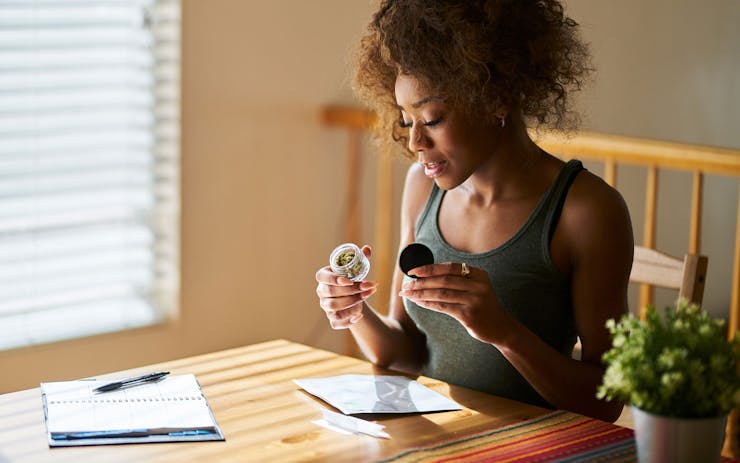With legalization, the cannabis market is rapidly expanding and the drive seems to be, in large part, to health and wellness, not getting high. This has meant an increased demand for no THC or low-THC edibles.
THC potency still dominates the flower market, but consumers are clearly looking for other components in the plant. More public education needs to happen, especially as new states with less sophisticated markets continue to legalize.
Dosage is an important part of the cannabis experience as well. If you don’t get enough potency from a 15% THC strain, it’s very easy to take another hit. When you start with a 30% THC strain, it’ll be harder for you to know if less would have been more.
Although THC is a beneficial compound, a high dose may turn off people who just want to take the edge off, not get zonked.
So why is it hard to find low-THC flower?
In the flower market, THC still rules
Post-legalization, the trend toward high-THC content in flower has continued unabated. But there is no research that indicates a high dose of THC is more beneficial for any medical condition or for a recreational experience.
In fact, a University of Illinois at Chicago study found that up to 7.5 mg of THC induced mild mood and well-being improvements, but 12.5 mg just made people more anxious.
Brad Bogus of Confident Cannabis says that people in the industry know THC potency is not the most important factor in quality cannabis, but the market is out of step. “Every operator I talk to exhibits a desire to lower the THC potency of the market, but at the same time they’ll also talk out of the other side of their mouths with the comment ‘but high THC is what sells.’”
And high-THC strains often have a higher price differential. According to Jeremy Plumb, Director of Production Science at Pruf Cultivar, “Producers can sell a 30% THC plant for $2000 a pound. A 25% THC plant can drop that down to $1200 a pound.” Even Pruf, which makes a strong effort to cultivate balanced strains with equal amounts of THC and CBD, has to carry high-THC strains to survive.
In addition, the seed stock for low-THC strains leaves a lot to be desired. Sayra Small, chief cultivator at Farley’s Cannabis Farm in Woolwich, Maine, says “As far as low-THC flower … I would like to carry some, but the breeding world is so focused on THC that the seed stock isn’t comparable.”
For cannaseurs like Confident Cannabis’ Brad Bogus, a pleasurable cannabis experience takes into account, not just cannabinoids, but other components of the plant. “When you love flower, kind of like wine, you’re looking for nuance, diversity, a whole spectrum of an experience. The higher the THC potency, generally speaking, the less diversity.”
What do people really want?
If one active ingredient—THC—is made to shine above all the others, and there’s limited education about it, it makes sense that flower consumers will prioritize THC.
But people want low-THC products. BDS Analytics reports that 43% of edible consumers prefer products containing less than 10 mg of THC per serving. Also, 54% of edible consumers in fully legal states choose products based on CBD content, and within this group, 58% prefer products with a higher ratio of CBD to THC or no THC at all.
The same report also found that more cannabis consumers care deeply about consistent dosing, and being able to carefully control the nature of their experiences.
According to Pruf Cultivar’s Plumb, when people don’t know what they’re smoking, low-THC seems to do well. The annual Cultivation Classic picks a random and diverse group of judges to sample different cannabis products. Plumb says that judges overwhelmingly select flower that is beneath 20% THC. “Routinely, people choose plants based on aroma intensity more than THC potency.”
This year the Cultivation Classic-Ladies Choice award went to Astral Works—a 2:1 CBD:THC ratio. It has an intense aromatic profile consistent with legacy haze plants and a moderate potency. Plumb says of the strain: “Here’s a bridge strain for a part of the market that is totally underserved and which stands to benefit from that kind of revisioned relationship to cannabis.”
It’s about the terpenes (and cannabinoids, flavonoids, etc.)
Growers like Sayra Small at Farley’s Farm know terpenes are important. “The most common question I get is ‘what is your highest THC strain?’ I inwardly roll my eyes because we all know that doesn’t make the best flower. What they should be asking is what has the most terpenes.”
But do consumers know the importance of terpenes? To find out, Confident Cannabis looked at flower samples tested at labs across 28 states. They looked to see if growers were electing to get terpene tests themselves, even though state regulations don’t require it.
The logic is, an increase in electing to test for terpenes would show that growers believe having that test is valuable, because consumers believe it to be valuable. Confident Cannabis found that elective terpene tests rose considerably over the past four years.
Brad Bogus thinks this is because the market is becoming better educated about the plant. “This could be in part to more consumers learning about terpenes … as well as growers wanting to ensure they’re hitting the mark on total terpene content, as well as learning what specific terpenes they’re producing harvest to harvest. Processors looking for terpene-rich extracts are yet another reason growers would opt into such a test,” he said.
As Plumb from Pruf Cultivar puts it, “Let’s meet people where they are. We’re all learning together about how to have a more mature relationship to this product.”





